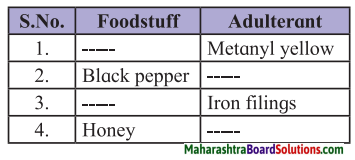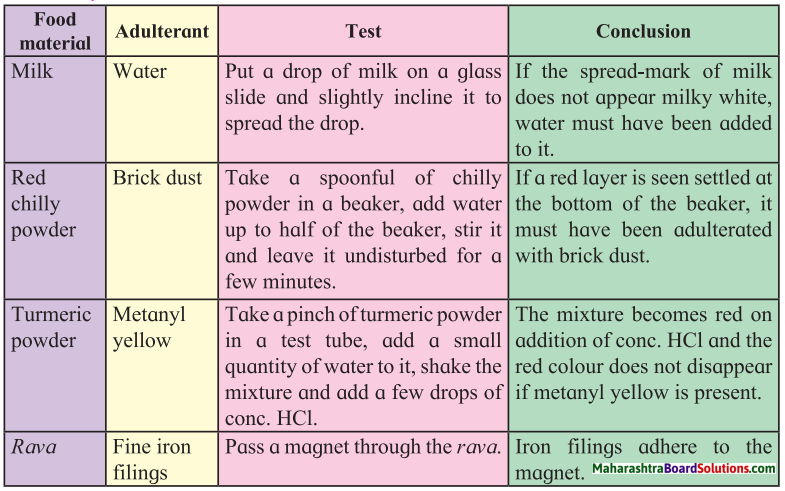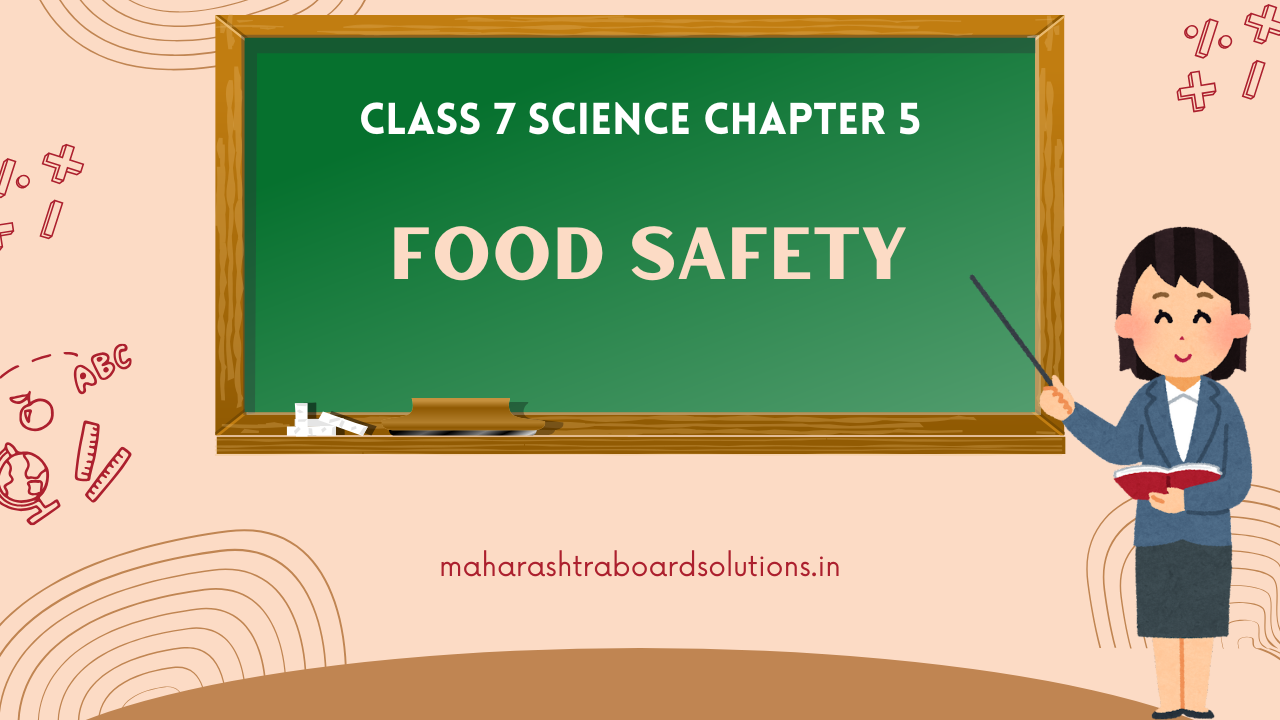Balbharti Maharashtra State Board Class 7 Science Solutions Chapter 5 Food Safety Notes, Textbook Exercise Important Questions and Answers.
Std 7 Science Chapter 5 Food Safety Question Answer Maharashtra Board
Class 7 Science Chapter 5 Food Safety Question Answer Maharashtra Board
1. Complete the following statements by using the correct option from those given below.
(Irradiation, dehydration, pasteurization, natural, chemical)
Question a.
Drying the food grains from farms under the hot sun is called …………. .
Answer:
dehydration
![]()
Question b.
Materials like milk are instantly cooled after heating up to a certain high temperature. This method of food preservation is called ……….. .
Answer:
pasteurization
Question c.
Salt is a ……….. type of food preservative.
Answer:
natural
Question d.
Vinegar is a …………. type of food preservative.
Answer:
chemical
2. Answer the following questions in your own words.
Question a.
How is milk pasteurised?
Answer:
Boil the milk at 80°C for 15 minutes and cool it quickly. This destroys the microbes present in the milk and it can remain for a longer duration. This process is called pasteurization of milk.
![]()
Question b.
Why should we not consume adulterated food materials?
Answer:
Different types of adulterants affect our health in different ways. Some adulterants cause abdominal discomfort or poisoning while some may affect the functioning of some organs if consumed over a long period of time or even cause cancer.
Question c.
What precautions do your parents take to keep foodstuffs safe?
Answer:
Our parents take following care to keep foodstuffs safe
- Drying of grains.
- Boiling of milk, soups and curries from time to time.
- Refrigeration of vegetables, fruits, milk and cooked food.
- Candying of jams.
- Use natural preservatives like oil, spices, neem leaves, salt, etc.
- Use chemical preservatives in sauces, ketchups, pickles, jams and squashes.
Question d.
How does food spoilage occur? Which are the various factors spoiling the food?
Answer:
Food spoilage is the process in which food deteriorates to the point in which it is not edible to humans or its quality of edibility becomes reduced.
Following are the factors for spoiling of food:
- Bacteria causes food to spoil
- Incorrect storage may spoil the food.
- Infestation by pests.
- Chemical reaction takes place in food and it gets spoiled.
![]()
Question e.
Which methods of food preservation would you use?
Answer:
I use following methods to preserve the food:
- Freezing
- Boiling
- Salting of pickles
- drying of grains
- candying of jams.
3. What shall we do?
Question a.
There are vendors selling uncovered sweet-meats in open places in the market.
Answer:
We should tell them to sell the covered sweets because uncovered sweets are harmful to eat because it contains dust, dirt and germs. And buyers also should not purchase these uncovered sweets.
Question b.
A ‘pani-puriwala’ is serving the panipuri with dirty hands.
Answer:
We should tell him to wear gloves before serving panipuri because dirty hands contain dirt and germs which are harmful to us.
Question c.
We have purchased a large quantity of fruits and vegetables.
Answer:
We should keep them in refrigerator because in refrigerator, due to low temperature, fruits and vegetables do not spoil and biological and chemical reactions in fruits and vegetables are slowed down at low temperature.
![]()
Question d.
We need to protect foodstuffs from pests like rats, cockroaches, wall-lizards etc.
Answer:
- If we do not protect foodstuffs from pests like rats, cockroaches, wall-lizards etc. then the food get spoiled by them and germs carried by them enters into the food.
- If we eat this food then we may get food poisoning and we fall sick so we need to protect foodstuffs from pests like rat, cockroaches, wall lizards etc.
4. Find the odd-man-out.
Question a.
Salt, vinegar, citric acid, sodium benzoate.
Answer:
Salt
Question b.
Lakhi dal, brick dust, metanyl yellow, turmeric powder.
Answer:
Turmeric powder
Question c.
Banana, apple, guava, almond.
Answer:
Almond
![]()
Question d.
Storing, freezing, settling, drying
Answer:
Storing
5. Complete the chart below.
Question a.

Answer:
| Foodstuff | Adulterant |
| 1. Turmeric powder | Metanil yellow |
| 2. Black pepper | Dried papaya seeds |
| 3. Rava | Iron filings |
| 4. Honey | Sugar, water and jaggery |
![]()
6. Explain why this happens and suggest possible remedies.
Question a.
Qualitative wastage of food.
Answer:
Qualitative wastage of food happens due to wrong methods of protecting food, excessive use of food preservatives, over-cooking, washing the vegetables after cutting them, mis¬handling of fruits like grapes and mangoes, miscalculation of the time required to transport food from producers to consumers are some of the reasons of qualitative wastage of food.
Possible remedies:
- Avoid overcooking of food.
- Store grains and other perishable foodstuffs like vegetables, fruits, milk etc. using proper methods.
- Wash fruits and vegetables before cutting it.
Question b.
The cooked rice is underdone.
Answer:
Sometimes in a hurry if we cook the rice it is underdone.
Possible remedies: Use proper pressure cooker to cook the rice.
Question c.
The wheat that was bought is a bit moist.
Answer:
Sometimes due to sudden rain, wheat gets a bit moist. Possible remedies: Do not store the moist wheat, it gets spoiled due to fungus so first sundry it and then store in a clean and dry container to avoid microbial growth.
Question d.
The taste of yoghurt is too sour/slightly bitter.
Answer:
The taste of yoghurt is too sour/slightly bitter means it is spoiled. This happens if it is not kept in the refrigerator.
Possible remedies:- Always keep the yoghurt in refrigerator to avoid biological and chemical reactions in food materials.
![]()
Question e.
Cut fruits turned black.
Answer:
Fruit contains an enzyme called polyphenol oxidase or tyrosinase that reacts with oxygen. The oxidation reaction basically forms a sort of rust on the surface of fruits so it turns black.
Possible remedies:
- Coat the fruits with sugar syrup
- Add lemon juice on fruits.
7. Give reasons.
Question 1.
Food remains safe at 5° Celsius.
Answer:
Food remains safe at 5° Celsius because at 5°C, micro-organisms stop growing.
![]()
Question 2.
Nowadays, food is served in buffet style during large gatherings.
Answer:
Nowadays, food is served buffet style during large gatherings because due to buffet style quantitative wastage of food can be avoided, as people take only as much as they could eat.
Project:
Question 1.
Go to your kitchen und take notes about the food safety measures and the food wastage you see there.
Question 2.
In a science exhibition demonstrate the various methods of detecting food adulteration.
Class 7 Science Chapter 5 Food Safety Important Questions and Answers
Complete the following statements by using the correct option from those given below.
(Irradiation, dehydration, pasteurization, natural, chemical)
Question 1.
………………………. is celebrated as “World Food Day”.
Answer:
16th October
![]()
Question 2.
FSSAI means ………………………. .
Answer:
Food Safety and Standardization Authority of India
Question 3.
………………………. gas is filled in tight packets of potato wafers.
Answer:
Nitrogen
Question 4.
Common name of acetic acid is ……………………….
Answer:
Vinegar
Question 5.
………………………. is sprayed on the gunny bags containing food grains.
Answer:
Melathion
![]()
Question 6.
………………………. is used in smoking method.
Answer:
Aluminium phosphide
Question 7.
………………………. and ………………………. are emitted by radioactive isotopes in irradiation method.
Answer:
X – rays, gamma rays
Question 8.
In Maharashtra, irradiation plants have been installed at ………………………. for onions and potatoes and at for spices and condiments.
Answer:
Lasalgaon, Navi Mumbai
Question 9.
………………………. found the pasteurisation method.
Answer:
Louis Pasteur
Question 10.
………………………. adulterant is added to turmeric powder.
Answer:
Metanyl yellow
![]()
Question 11.
………………………. adulterant is added to red chilly powder.
Answer:
Brickdust
Question 12.
………………………. is used to make fruits more attractive.
Answer:
calcium carbide
Question 13.
………………………. and ………………………. harmful chemicals are mixed with cold drinks.
Answer:
carbonated soda, phosphoric acid
![]()
Question 14.
Shopkeepers change the of the ………………………. food packets fo avoid a financial loss.
Answer:
expiry date
Question 15.
Milk vendors add ………………………. to the milk to appear as higher fat content.
Answer:
urea
Question 16.
The shelf life of potatoes and onions ………………………. due to slowed-down of sprouting.
Answer:
increases
Question 17.
Serving too much food to guests at traditional feasts and banquets leads to ………………………. wastage of food.
Answer:
Quantitative
![]()
Question 18.
Miscalculation of the time required to transport food from producers to consumers leads to ……………………… . wastage of food.
Answer:
Qualitative
Question 19.
Prevention of food spoilage by microbial growth and infestation by pests is called ………………………. .
Answer:
food protection
Question 20.
………………………. is an example of a chemical preservative.
Answer:
Sodium benzoate.
Say whether True or False,, Correct and rewrite the false statement.
Question 1.
To prevent adulteration of food, it is inspected by the “Food and Drug Administration department of the government”.
Answer:
True
![]()
Question 2.
Overcooking of food increases the quality of food.
Answer:
False. Over cooking of food spoils it
Question 3.
Peanuts become rancid then, it is not good to eat.
Answer:
True
Question 4.
Oil and ghee contain fats.
Answer:
True
Question 5.
Prevention of food spoilage by microbial growth and infestation by pests is called food wastage.
Answer:
False. Prevention of food spoilage by microbial growth and infestation by pests is called food protection.
![]()
Question 6.
Serve yourself only as much as you can eat.
Answer:
True
Question 7.
Salt, sugar and oil are naturally available preservatives.
Answer:
True
Question 8.
Pickles can be preserved by salting.
Answer:
True
Question 9.
Milk vendors add urea to the milk so that it appears to have higher fat content.
Answer:
True
![]()
Question 10.
Shelf life of fruits and vegetables decreases by gamma rays emitted by radio-active isotopes.
Answer:
False. Shelf life of fruits and ‘ vegetables increases by gamma rays emitted by radioactive isotopes.
Give scientific reasons.
Question 1.
Refrigerators are used in the kitchen.
Answer:
- Biological and chemical reactions in food materials are slowed down at low temperature.
- As a result food remains in good condition for a longer period. Therefore refrigerators are used in the kitchen.
Question 2.
Potatoes and onions are treated with gamma rays.
Answer:
Potatoes and onions are treated with gamma rays because irradiation with gamma rays prevents their wastage due to sprouting and increases their shelf life.
Question 3.
Grains are sun-dried.
Answer:
Grains are sun-dried to preserve them because on sun drying their water content gets reduced and hence they last longer.
![]()
Question 4.
We boil milk from time to time.
Answer:
We boil milk from time to time to kill microorganisms in it and thus prevent it from getting spoilt.
Question 5.
Jams or pickles get spoilt if their jars are not sealed properly.
Answer:
If the jar is not sealed properly, micro¬organisms from the air enter in the jar and start growing on the food. Oxygen in the air helps the micro-organisms and fungi to grow faster and hence bring about the spoilage of the jams and pickles.
Question 6.
Some vendors add urea to the milk.
Answer:
Some vendors add urea to the milk so that it appears to have higher fat content.
Question 7.
Food wastage should be avoided.
Answer:
In countries like India, the food requirement is plenty and people do not get proper meals even once in a day. If food is not wasted then it could have met the need of many others. Therefore, food should not be wasted and proper measures should be implemented to stop quantitative and qualitative wastage of food.
Question 8.
Adulterated food should not be consumed.’
Answer:
- The health of all people is endangered by food adulteration.
- Different types of adulterants affect our health in different ways.
- Some adulterants cause abdominal discomfort or poisoning, while some may affect the functioning of some organs if consumed over a long period of time or even cause cancer.
![]()
Can you tell?
Answer the following questions:
Question 1.
How and where food is wasted?
Answer:
Quantitative wastage of food:
1. Wrong methods of farming like hand sowing of, ts seeds, inadequate threshing, improper storage and wrong methods of distribution are some reasons for quantitative wastage of food.
2. Besides, much food is wasted as a result of the custom of offering and serving too much food to guests at traditional feasts or banquets.
3. Had it not been wasted, all this food could have met the need of many others Qualitative wastage of food: Using wrong methods of protecting food, excessive use of food preservatives, over-cooking, washing the vegetables after cutting them, mis-handling of fruits like grapes and mangoes, mis-calculation of the time required to transport food from producers to consumers, are some of the causes of quantitative wastage of food.
![]()
Question 2.
How is the food adulterated?
Answer:
Food is adulterated by the following ways:
- Removal of some important components of food. e.g. removal of fat content of milk, essence of cloves, cardamoms, etc.
- Mixing of a low quality inedible or cheaper material or harmful colour with food.
- Mixing of some harmful materials like small stones, fine sand, iron filings, urea, dung of horse, sawdust etc.
How will you find out if food has been adulterated?

7th Std Science Questions And Answers:
- The Living World: Adaptations and Classification Class 7 Questions And Answers
- Plants: Structure and Function Class 7 Questions And Answers
- Properties of Natural Resources Class 7 Questions And Answers
- Nutrition in Living Organisms Class 7 Questions And Answers
- Food Safety Class 7 Questions And Answers
- Measurement of Physical Quantities Class 7 Questions And Answers
- Motion, Force and Work Class 7 Questions And Answers
- Static Electricity Class 7 Questions And Answers
- Heat Class 7 Questions And Answers
- Disaster Management Class 7 Questions And Answers
